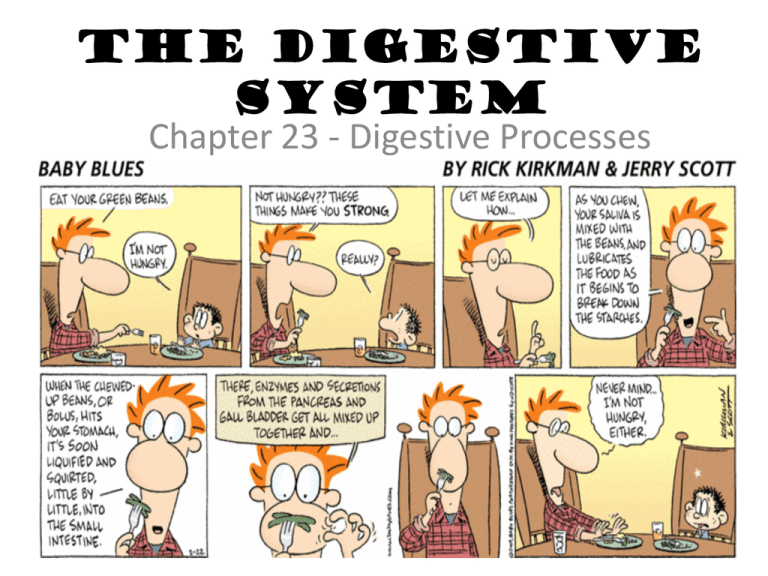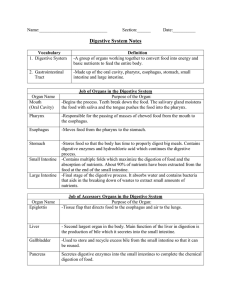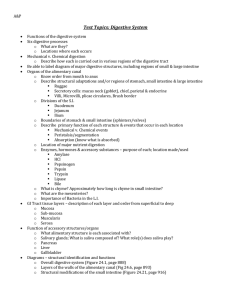Digestion
advertisement

The Digestive System Chapter 23 - Digestive Processes Digestive Processes in Mouth, Pharynx, Esophagus • Mouth ingests, begins mechanical digestion, initiates swallowing, and starts chemical digestion of polysaccharides (starches and glycogen)into smaller fragments. • If you chew a piece of bread for a few minutes, it will begin to taste sweet as sugars are released. • Essentially no absorption occurs. Digestive Processes in Mouth, Pharynx, Esophagus • Mastication (chewing) mechanical digestion – Cheeks and closed lips hold food between teeth, the tongue mixes food with saliva to soften it, and the teeth cut and grind solid foods into smaller pieces Digestive Processes in Mouth, Pharynx, Esophagus - Swallowing • Deglutition (Swallowing) • Involves over 22 muscles! • Buccal phase occurs in mouth and is voluntary. Initiated by the tongue Digestive Processes in Mouth, Pharynx, Esophagus • Pharynx and esophagus merely serve as conduits to pass food from the mouth to the stomach. • Only function in food propulsion, accomplished by the role they play in swallowing. Digestive Processes in Mouth, Pharynx, Esophagus - Swallowing • Pharyngeal-esophageal phase involuntary, activated when food reaches receptors in the posterior pharynx • Once food enters the pharynx, respiration is momentarily stopped and all routes except that to the digestive tract are blocked off: – The tongue blocks off the mouth – Soft palate rises to close off the nasopharynx – Epiglottis covers the glottis Digestive Processes in Mouth, Pharynx, Esophagus - Swallowing • Solid foods travel to the stomach in about 2-8 seconds. • If we try to talk or inhale while swallowing, the protective mechanisms may be shortcircuited and food may enter respiratory passageways. Digestive Processes in Stomach • Serves as a holding area for ingested food. • Degrades food both physically and chemically. • Then delivers chyme, into the small intestine. Digestive Processes in Stomach • Protein digestion is started in the stomach only type of enzymatic digestion that occurs. • Proteins are denatured by the HCl proteins are unfolded which makes them more accessible to enzymes. Digestive Processes in Small Intestine • Food reaching the small intestine is unrecognizable, but it is far from being chemically digested. • Carbohydrates and proteins are partially degraded, but virtually no fat digestion has occurred. Digestive Processes in Small Intestine • Chyme spends 3-6 hours in the small intestine. During this time absorption of water and virtually all nutrients occur. •Optimal activity also depends on a slow, measured delivery of chyme from the stomach. Gives time for the modification of the pH and the mixing with the digestive juices so that digestion can be continued. Digestive Processes in Small Intestine • Anything that inhibits liver or pancreas function or delivery of their juices to the small intestine severely hinders our ability to digest food and absorb nutrients. Digestive Processes in Small Intestine • Segmentation is the most common form of movement (and mixing) in the small intestine looks like the intestinal contents are being massaged the chyme is simply moved back and forth in the lumen a few centimeters at a time. Digestive Processes in Large Intestine • What is finally delivered to the large intestine contains few nutrients, but it still has 12-24 hours more to go! •Some digestion of the residue by bacteria, no further food breakdown of food occurs in the large intestine. Digestive Processes in Large Intestine • Harvests vitamins made by the bacteria and reclaims most of the remaining water and some electrolytes (sodium and chloride). • Absorption is not the major function of this organ. Function is the propulsive activities that force the fecal material towards the anus and then eliminate it from the body (defecation). Digestive Processes in Large Intestine • Large intestine is important for our comfort, but not essential for life. If the colon is removed, the terminal ileum is brought out to the abdominal wall in a procedure called ileostomy, and food residues are eliminated from there into a sac attached to the abdominal wall.








